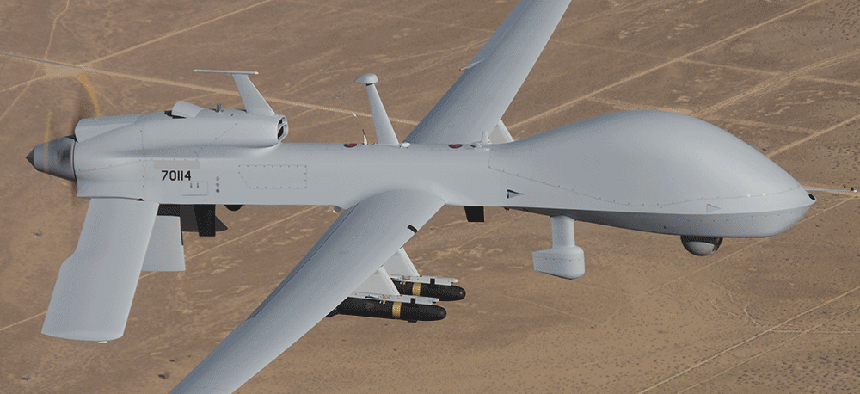Beam-switching tech successfully tested on Predator drone
Hopping between narrower satellite beams could increase data transfer and resiliency for the military's unmanned aerial systems.
Two satellite beams (or more) are better than one when it comes to data transfer and anti-jamming measures between satellites and drones. At least that’s what last month’s first successful test of beam-switching technology on an MQ-9 Predator drone seemed to show.
Over the course of the testing, the drone flew 1,075 nautical miles and was able to switch smoothly between two spot beams multiple times throughout the trial.
While traditional wide-beam satellites use one beam to cover thousands of miles, the satellites using the Intelsat Epic NG platform use spot beams that are just about 600 miles across, Intelsat General President Skot Butler, told Defense Systems.
“These tests demonstrate the capability … to support aircraft as they travel long distances across multiple spot beams,” Butler said. “The images and other data collected by unmanned aircraft systems are critical for many military operations.”
“It depends on the operational area that the vehicle needs to cover as to how many beams it might need to go through,” explained Butler. “If [the drones] have to travel a long distance from where they launch the vehicle to where they are going to do their collection then the drones may pass through multiple beams, but for many it will depend where they are in the beam when they launch and how far they are going.”
The newly tested beam-switching technology for the Predator drone has two primary benefits: improved data transfer and improved resiliency.
Using spot-beam instead of wide-beam architecture provides much higher throughput. By re-using the same frequencies to send multiple data signals over a smaller, more concentrated area, spot beam technology on the Epic NG platform provides military drones with bandwidths two to six times greater than that of commercial wide-beam technology, according to Intelsat.
The second major benefit is anti-jamming resilience.
In order to disrupt the satellite signal, a jammer must be operating within the same beam as the signaling drone, explained Butler. While this was easy when beams span entire continents, it is much more difficult when the jammer must be within the exact 600 miles of the same spot-beam as the drone.
Additionally, the platform enhances resiliency by separating the uploading signal from the downloading signal, so that operators can disconnect from one or the other without disrupting the overall signal.
“The digital payload essentially allows you to disconnect the up link signal from the down link signal,” Butler explained. “So if somebody is jamming the signal, we can just disconnect that jammed signal, find the UAV a new frequency, and reestablish a link, essentially neutralizing the jamming signal...”
The beam-switching technology might soon be ready for smaller drones as well. The sheer signaling power of Intelsat’s high throughput satellites means that receiving antenna can be smaller, Butler said, and are now small and light enough to be deployed on small drones.
The test was conducted using the Intelsat General’s Intelsat 29e satellite, part of the Intelsat Epic NG platform, with the Block 5 Predator B/MQ-9 drone. It was based out of Grand Forks Air Force Base in North Dakota.




